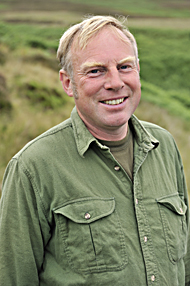
| HOME |
| PROJECT DETAILS |
| PROJECT ADMINSTRATION |
| JOINT RAPTOR STUDY |
| THE MOOR |
| THE GROUSE |
| THE RAPTORS |
| OTHER WILDLIFE |
| DIVERSIONARY FEEDING |
| GAMEKEEPING |
| WILDLIFE SURVEYS |
| NEWS |
| CONTACT |
| PHOTO GALLERY |
| Simon Lester's gamekeeping diary |
October 2010 LOOKING out over the moor, although the grass is dying off quickly, some of the lightly beetled heather is starting to show signs of life and green up. We have resumed catching grouse for radio tagging and collecting caecal droppings (to test for worm burdens); we are aiming to tag and look at the droppings from a good spread of birds across the entire moor. We have found the hen harrier’s satellite tag we were searching for when my last diary entry was published. We picked up a strong signal from the area where we first searched, so Damian Bubb and I set off once again, this time equipped with a modified receiver. And, fortunately, it was not long until we picked up a strong signal, which led us to the long lost tag. Strangely though, we could not find any remains of the harrier that the tag had been attached to! So we have a mystery on our hands; the tag has been sent for DNA testing, which we hope may reveal some clues as to the fate of the bird. The other tagged young harriers are continuing to do well. One is still in the Lammermuirs, but another, a cock, has got a real lust for travel. He spent some time in Wales, moved down to Cornwall and then crossed the channel to France where he settled in an agricultural area of Brittany. I have been waiting for, and have now received, permission to spray off more Molinia with Glyphosphate. The only problem is getting a dry spell, as September was quite damp up here. We now face a race against time and the weather, as the chemical is not so effective once the grass starts to die back. Booking a contractor to do the work with a tractor and reasonable-sized sprayer also proved difficult due to the late harvest. Thankfully, it all came good in the end and we eventually managed to spray 21 hectares. The grass that we managed to spray last year has had to be chopped as the weather beat us for burning. But I am pleased to report that in some of the areas chopped last year, the regenerating heather is looking good. With this in mind, we have now chopped the rest. We are also beginning a small trial to compare the effects of several treatments on the beetled heather. I remain astonished that we know so little about the beetle – and how to manage its impacts. All the Project keepers, myself included, have been surprised at the number of foxes that have recently come onto our area. There has been a run of dogs, both adults and this year’s cubs. We still find lots of grouse kills that have mostly been taken by raptors and the odd one by a fox. It looks as though the mustelid numbers have gone up this year, as they have been leaving lots of footprints in the scientists’ monitoring tunnels. So far, indications show that that weasels, in particular, have had a good breeding season. It seems that although we are trapping more weasels, the population is on the up – presumably because there are now less foxes and more voles about. We can manage this by increasing the amount and range of our traps. But it just goes to show that nature works through many connections, with the ups and downs of predators and prey continuing to baffle and tantalise us in equal measure.
|
